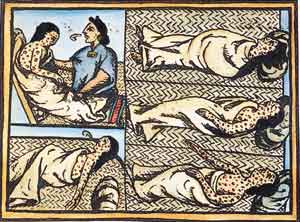As
improbable as it seemed at the beginning, these low-tech efforts
obliterated the deadly disease. Records of the horror of smallpox
epidemics exist in Hindu manuscripts 3,000
to 4,000 years old, and the disease has been etched into the
history of every country and culture. In the 20th century
alone, smallpox killed at least 300 million people and left
tens of millions of survivors horribly scarred, disfigured,
and grossly impaired.
 |
|
New
World Indians, with smallpox contracted from European
settlers, ministered to by a medicine man: illustration,
16th century.
|
The eradication
of smallpox was arguably the greatest triumph in medical history.
Never before had the efforts of health workers led to the
disappearance of any infectious disease, let alone a viral
disease. Although viruses are relatively uncomplicated in
structure, almost nothing else about them is simple. Most
are little more than a string of genes surrounded by a protein
overcoat. Some are also bounded by a fatty envelope. They
are not cellular in structure and lack the ability to carry
out an independent metabolism. Strictly speaking, viruses
are not alive, although they share important attributes with
living things. Viruses can infect living cells and reproduce
before destroying the very cells they briefly called home.
As they have genes, they can mutate and, in time, viral populations
evolve.
Despite
the simplicity of its structure, researchers know relatively
few details about how the virus causes such gross pathology.
Although there are vaccines to protect uninfected people
from acquiring some viral infections, there are no medications
capable of curing patients already infected. No viral disease--not
hepatitis, polio, influenza, nor AIDS--has ever been cured
by medicine. Smallpox, an illness with no known cure and
caused by a deadly virus whose lethal mechanism is not well
understood, was the first infectious disease to be wiped
out.
Henderson
directed the WHO Smallpox Eradication Unit from the beginning
to the end of this incredible effort, hoping that he and his
colleagues would live out their lives with the assurance that
their accomplishment had been an unambiguous boon to humankind.
Unfortunately, that was not to be.
After
the pronouncement that smallpox was gone, WHO tackled the
thorny issue of what to do with remaining smallpox virus
stocks stored in laboratory freezers at sites around the
world. WHO recommended the destruction of all stocks except
for those in two places: the United States Center for Disease
Control in Atlanta, and the Institute for Viral Preparations
in Moscow. Research would continue at these two sites with
the goals of finding the DNA chromosome in isolates of the
virus and replicating the chromosome in a virus-free environment--in
fact, genetic cloning. This would determine the exact sequence
of DNA subunits in the chromosome, allowing scientists to
study safely the genes of this killer without using an intact
virus.
In
1972, even before smallpox had disappeared, the U.S. halted
almost all smallpox vaccinations except for medical staff
working with the virus and some military personnel. Today
almost no Americans younger than 28 (more than 100 million
people) have protection. For the rest of us, the question
of vulnerability is not at all clear. The duration of
smallpox vaccine protection has never been satisfactorily
determined. It is likely that most people from around
the world are vulnerable to its ravages if the disease
ever reappears.
The
final WHO recommendation was that on June 30, 1999, all
remaining virus stocks be destroyed. The rationale made
sense: it seems pointless to immunize people against a
non-existent disease. Almost half the world population
is unprotected, and a single case of smallpox anywhere
would create a medical emergency of unparalleled urgency.
According to WHO, the only possible sources of a new outbreak
are the vials of virus stocks stored in freezers in Atlanta
and Moscow. Destroying them would forever eliminate the
risk of a laboratory accident that could trigger a tragedy.
Thus
the uncomplicated recommendation of WHO was proposed as
the next logical step, which would presumably be the last.
Sadly, this is where the story turns ugly and where the
interconnectedness of all things becomes manifest.
Unless
we are truly a world gone mad, the assumptions underlying
the WHO recommendations began with the idea that the eradication
of smallpox was a magnificent boon for the common good
of all people, regardless of nationality or allegiance.
Another assumption was that scientists and governments
and all specialists with relevant expertise would cooperate
in ensuring that the disease would never again inflict
its horror. It was unthinkable that any individual or
group or government would abuse that tacit trust to further
their own political or economic or ideological goals.